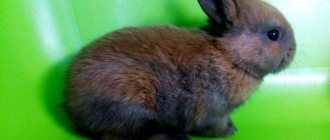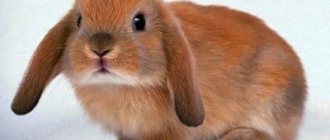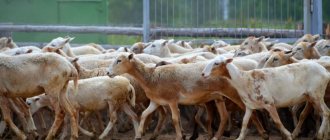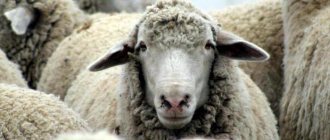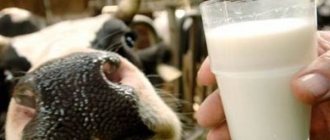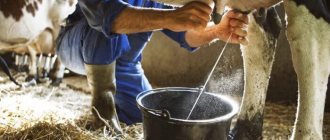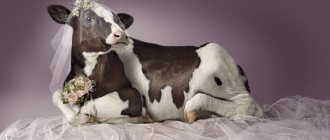The dwarf buffalo lives only in Indonesia. This baby is often called the Sulawesi buffalo. This unique animal is listed in the International Red Book. “Thanks to” the massive, both legal and illegal, deforestation of Sulawesi forests, the animal does not live throughout the large island of Sulawesi, but only in small protected areas protected by law.
This little buffalo is officially called anoa
This small buffalo is officially called anoa . Males weigh 300 kg. Females are half the size - 150 kg. The buffalo from the island of Sulawesi is almost 2.5 times shorter than its “normal” relative - 80 cm. It also has smaller horns, up to 25 cm long. The dwarf among buffaloes seems like just a baby. If you're lucky, a dwarf buffalo can live about 20 or 25 years.
Graceful and intelligent miniature poodle
Taxonomy of the species
Anoa are called dwarf buffalos. This species consists of 3 subspecies: lowland anoa, Carles anoa and mountain anoa. All these animals are in the Red Book.
The taxonomy of the species is not clear. The differences between the mountain anoa and the Carls anoa are not sufficient for them to be distinguished into separate forms. It is unlikely that this issue will be resolved, since there are not enough materials in the collections to allow the necessary research to be carried out, and the likelihood of obtaining new specimens is extremely negligible.
Anoa (Bubalus depressicornis).
Causes of extinction
Massive deforestation. For anoa and tamaraw, the forest acts as protection from humans and predators, as well as a main source of food. And as the amount of forest on the islands decreases, the population of the species also decreases. Poaching. Local populations in the Philippines, Africa and Indonesia widely use mini-buffalo horns and skins in their rituals and ceremonies.
In addition, their tender meat is highly valued, so even the ban on killing these animals does not stop hunters. Increase in the number of inhabitants of the islands. Despite the large size of the island of Mindoro, due to the rapid growth of its population, the tamaraw's habitat is rapidly shrinking. Accordingly, such displacement of animals affects their numbers.
Tamaraw
Appearance of a dwarf buffalo
Anoa is the smallest member of the wild bull family.
Plain anoas reach a height of approximately 1 meter at the withers, Carles's anoas are lower, they grow up to 63 centimeters, and mountain anoas - up to 75 centimeters.
All three subspecies have a strong build. The body is massive, the legs are short and powerful, and the neck is thick. The color of adult individuals ranges from dark brown to black, with males having a darker color than females. There are small white spots on the body. Adults have virtually no hair, but the skin is incredibly thick. Babies have shaggy fur and much lighter colors.
The horns are triangular at the base, while the Carles subspecies has conical horns. Then they become almost straight and slightly ribbed. The length of the horns is approximately 40 centimeters.
Anoa is smaller than other buffaloes, and adult animals are almost hairless.
Indian buffalo
Unfortunately, powerful Asian or Indian bulls are currently quite rare in the wild . This is facilitated by the frequent mating of wild individuals and domestic ones, which leads to mixing of blood and, as a consequence, to the degeneration of the water buffalo species. To correct this situation, the authorities of the countries where this animal is found are creating nature reserves that protect the giants from the influence of human activity, and also increase their numbers artificially.
Appearance of an Indian bull
The Indian or water buffalo is rightfully considered one of the largest land mammals.
With a height of about two meters, its length reaches four meters, while the weight of the bull often exceeds one ton .
With such parameters, the powerful animal surpasses even its famous African brother. The giant's physique is also impressive. His huge body is supported by long and strong legs. And the mighty head is crowned with curved horns, rising up and slightly back. The horns of an adult Asian bull can reach one and a half meters in length. Females of this species are slightly more modestly armed, their horns are straight and smaller.
It is difficult to imagine the full power of such a bull; only one thing can be said for sure – it is enormous. Even the tail of an Asian buffalo, which reaches a length of about 90 cm, can cause serious injury.
It is worth noting that only wild individuals can boast of such dimensions. Their domestic counterparts are smaller . Nevertheless, the life expectancy of giants is quite high, on average it is 24 years.
We also recommend reading:
Musk ox (musk ox): behavior, nutrition, habitat What is rodeo or bull racing Where do buffaloes live and live: raising domestic bulls Dwarf buffalo: lifestyle of the smallest bull
Gallery: Indian and African buffalos (25 photos)
Indian buffalo habitat
The Asian buffalo rightfully bears the name “water bull”. This animal spends most of its time in water, where it feels more than comfortable. Typically, animals submerge completely in water, leaving only their horned head on the surface. This lifestyle requires that:
- water bulls are found in various reservoirs;
- located at a sufficient distance from cities.
Also, based on the name of the animal, one can assume that its habitat is located only in India, but this is incorrect. Water bulls are called Asian, as they are found in other Asian countries , such as Bhutan, Nepal, Thailand. In addition, there is the Indonesian buffalo, which, as the name suggests, lives in Indonesia.
Use in the national economy
The Asian bull is now bred in many Asian countries. Bulls successfully replace tractors when cultivating land for arable land, and transport people and cargo. But people use not only the physical strength of these animals. As livestock, bulls provide people with:
- lots of meat
- full fat milk;
- the buffalo provides the owners with delicious cheese ;
- animal skins and horns also find their use in the hands of a skilled craftsman.
Anoa lifestyle
Dwarf buffalos live in jungles and forests. They are solitary, but can live in pairs and rarely form small groups.
The diet of dwarf buffaloes consists of herbaceous vegetation, shoots, leaves, fruits, and they often eat aquatic plants. Anoas tend to graze in the morning. When it’s hot, they spend time near the water, where they willingly swim and have mud baths.
Anoa walk slowly, but in times of danger they switch to a fast gallop, which is rather clumsy for them.
The rut of dwarf buffaloes is not associated with a specific time of year. Pregnancy lasts about 300 days.
Nowadays the anoa are under threat of extinction.
Enemies of the Plains Anoa
This species of bull inhabits lowland forests, which apparently contributed to their name. Anoa can often be found in swamps or mangrove forests. Dwarf buffaloes are present in the Tanjung Peropa and Tanjung Amolengo Nature Reserves due to the presence of water sources, a wide food supply and fruit-bearing trees. Lowland anoa were also found high in the mountains.
The diet of wild anoa includes herbaceous vegetation, leaves, ferns, palm branches, shoots and fruits that animals pick up on the ground. Dwarf buffalos have been observed to consume seawater, which is believed to be able to meet the mineral requirements of bulls living in areas without mineral water sources.
Adult lowland anoa are not afraid of any enemies, with the exception of humans, of course. But as for young anoas, they are often hunted by pythons and civets.
If you find an error, please highlight a piece of text and press Ctrl Enter.
Another Lilliputian buffalo of the artiodactyl mammal family lives directly on the Eurasian continent. This is a dwarf buffalo from the island of Sulawesi called anoa. Very often, huge groups of these representatives can be found directly in Indonesia. Due to this, this variety is often called the famous dwarf buffalo from the island of Sulawesi.
The dwarf buffalo, or anoa, is truly small in size. The weight of males reaches 280 kg, and in females it is 2 times less. As for their length, it averages 80 cm or a little more. The dwarf buffalo of the anoa variety most often has a pure brown color, but sometimes there are representatives with black hair.
This dwarf buffalo of Indonesia, mainly living in the forests of Asia and its tropical parts, has a completely calm character. It is this factor that does not give him the opportunity to defend himself in front of large animals. If a person encounters this animal, then there is no need to be afraid of it, since it will not cause any harm.
Naturally, many consider such a classification to be arbitrary, but in fact they have distinctive features. The dwarf species that lives on the plains, compared to the mountain representative, has a very long tail and also a horn. Often such a small wild buffalo ends up in bordering areas.
Anoa is endemic, that is, it has a pronounced specificity within the general population of Asian buffaloes and lives in a limited area of a small area.
Lowland - lives only on the island of Sulawesi. You can often find anoa under the name Celebes dwarf buffalo. This name is given to the animal in honor of the island where it lives. Traditional European name for the island of Celebes.
The mountain representative is also found on the neighboring Butung Island. The difference in the habitats of mountain and lowland populations is clear from the names: some prefer lowland areas, others live in the mountains.
Natural habitat is pristine tropical forests. Lowland individuals live solitarily in lowland forests and wetlands, open forests and undergrowth. The habitat boundaries of lowland and mountain populations often intersect at the foothills of mountains and hills. Cases of being together in one place have been recorded.
Anoa is on the verge of extinction. In the second half of the 20th century, the number of animals decreased by 97%. Hunting played a primary role in such rapid extermination. Buffalo is valued by local residents as a source of horns, meat and hide.
The range has shrunk significantly over the past decades, and today is limited to small reserves that are closely guarded and constantly monitored. The local population also provides assistance in preserving the animals, as they understand the importance of these bulls for the local unique ecosystem.
Read more: How to get rid of mites on lemons. Lemon scale - fight and how to get rid of it
Reasons for the reduction in numbers:
- habitat destruction and transformation;
- agricultural plowing;
- deforestation;
- settlement of hard-to-reach territories;
- hunting and poaching.
Scientific research shows that lowland and mountain anoa periodically interbreed. This situation leads to hybridization and mixing of characteristics.
The pygmy buffalo populations were initially thought to be a single species, with differences arising from the dramatic difference in habitat on the island. But recent DNA tests have shown that lowland and mountain anoa are representatives of different species. The ancestors of the dwarf buffalo lived in the northern regions of India.
Nowadays, even wild buffalos live mainly in protected areas. The historical range of these animals is very wide. For thousands of years, wild oxen lived from China to Mesopotamia.
African buffalos live in Africa on endless savannas, as well as on the sparse, bush-covered steppes of the southern Sahara. Most African wild bulls are found in the southern and eastern parts of the continent. Previously, this species was distributed almost everywhere; there were more than 35% of them among representatives of all large breeds of artiodactyls.
This species adapts well to different types of vegetation and soil. They live in savannas, dense tropical forests and swampy meadows. Buffaloes easily climb mountains to heights of up to 300 meters. Since these animals are herbivores, they mainly live in dense, humid savannas. Animals are very dependent on water, so they try to settle near bodies of water.
Indian buffaloes live in Southeast Asia. They live in small groups of about 10 individuals. Since the 19th century, this species has been widespread in Australia, and very widely in the northern part of the mainland. This species of animal mainly feeds on aquatic vegetation. In the early morning hours and in the evening, they graze on pastures, and spend the rest of the time in the water. They live mainly in the countries:
- Nepal;
- India;
- Thailand;
- Cambodia;
- Laos.
Tamaru and anoa are rare species of buffalo. They are found only in certain places on the planet. Tamara live only in the Philippines on the island of Mindoro. Anoa can be found in Indonesia on the island of Sulawesi. They prefer to live near the shores of local water bodies, as well as in the darkened edges of tropical forests.
Despite their impressive size, these animals live only in groups. Alone, they can become prey for lions, hyenas and other predators.
Anoa is endemic to the Indonesian island of Sulawesi. These bulls inhabit dense tropical forests, feed on leaves, fruits, grass, drink a lot, love to swim and wallow in the mud. They are sedentary, staying within their territory in monogamous pairs or small family groups. Anoa has no seasonality in reproduction.
